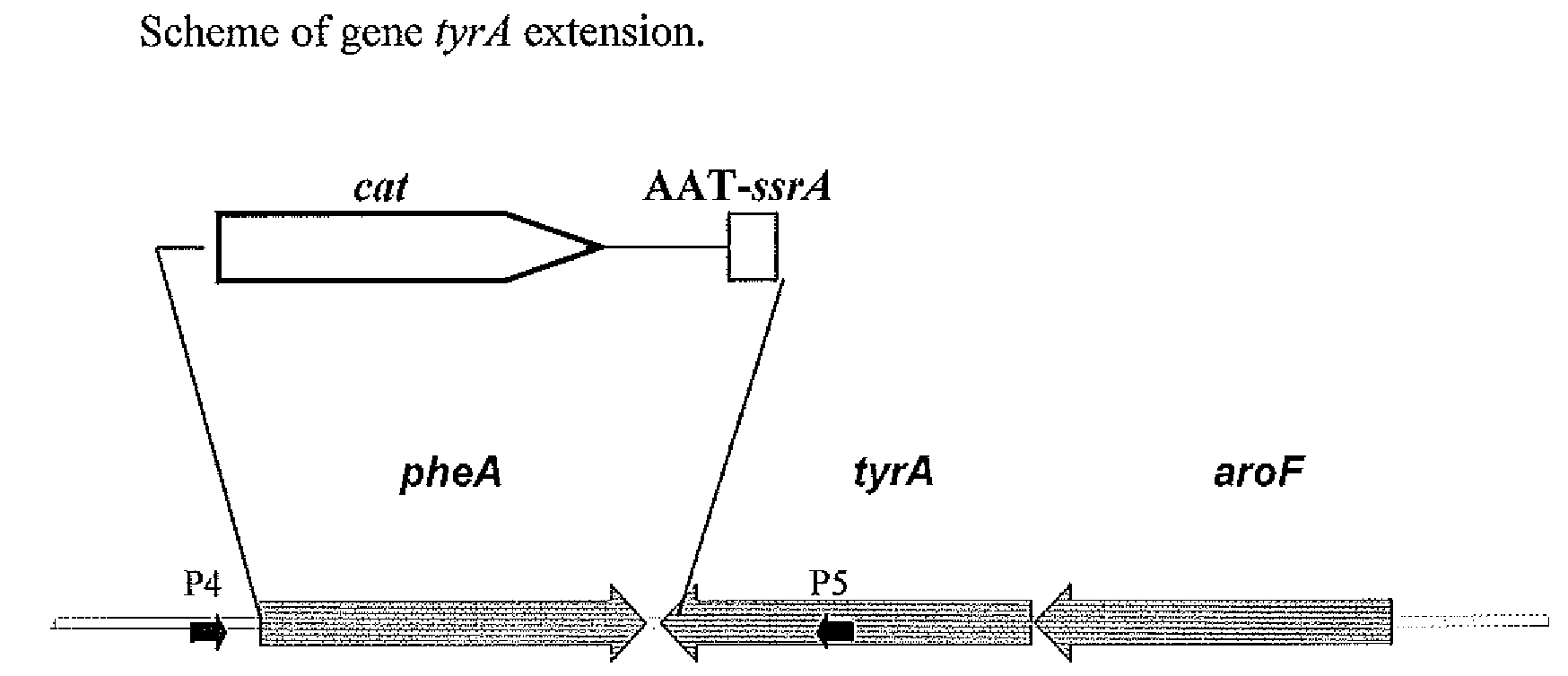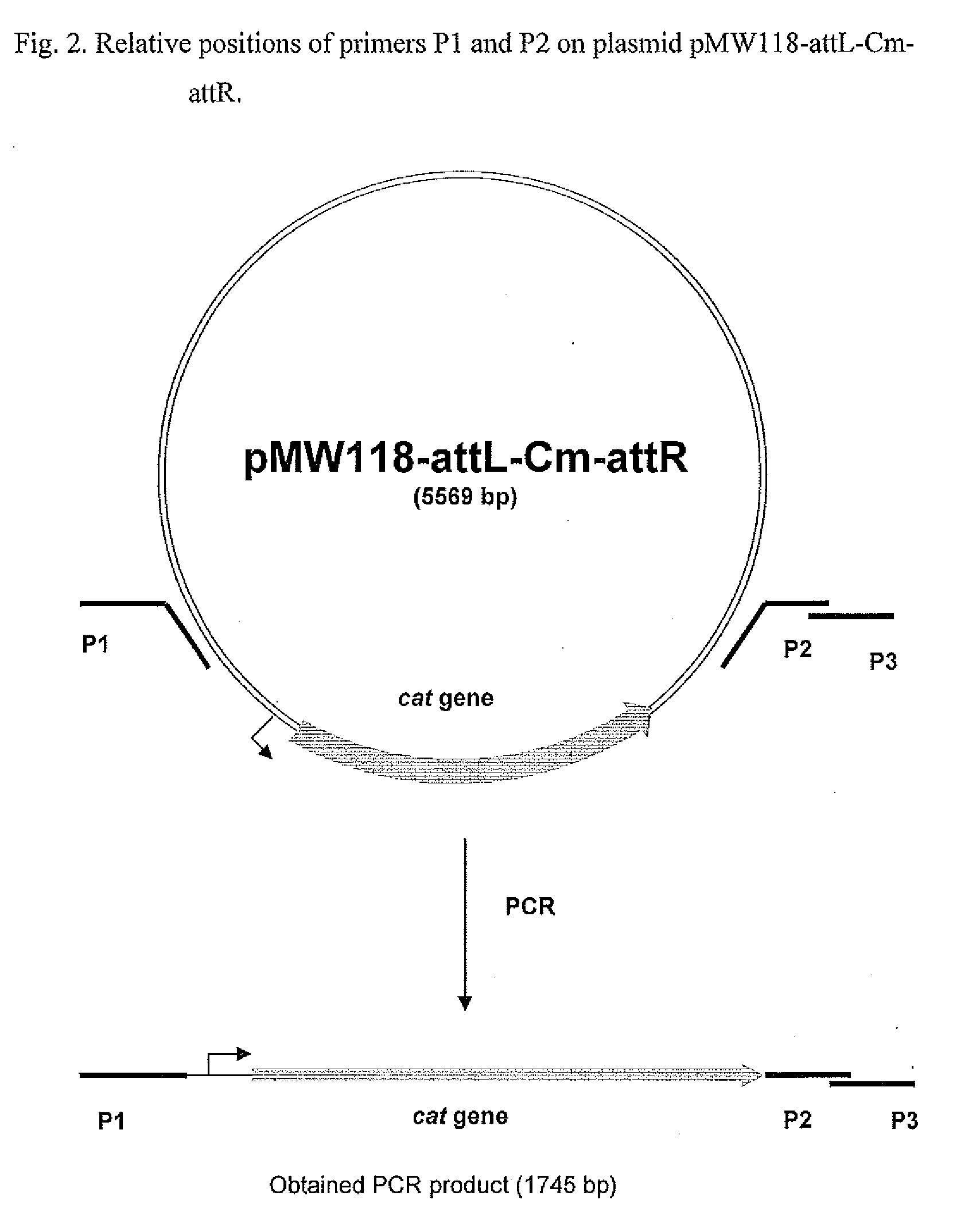Method for producing amino acids using bacterium of the enterobacteriaceae family
a technology of enterobacteriaceae and amino acid, which is applied in the direction of enzymology, bulk chemical production, transferases, etc., can solve the problems of reducing the ability of the bacterium to produce the target compound, affecting the production of target amino acids, so as to enhance the production of the target amino acid, enhance the production of those amino acids, and enhance the productivity of the l-amino acid-producing
- Summary
- Abstract
- Description
- Claims
- Application Information
AI Technical Summary
Benefits of technology
Problems solved by technology
Method used
Image
Examples
example 1
Construction of the E. coli Strain MG1655ΔtyrRtyrA-ssrA, which Contains the Mutant tyrA-ssrA Gene
[0104]1. Substitution of the Native pheA Gene and 36-nt Located at the 3′ End of tyrA Gene Region, in E. coli with the Mutant tyrA-ssrA Gene.
[0105]To substitute the native pheA gene and 36-nt located at the 3′ end of tyrA gene region, a DNA fragment carrying 1) the 36-nt located at the 5′ end of pheA gene, 2) cat gene with attL and attR sites, 3) a DNA fragment encoding the chloramphenicol resistance marker (CmR), 4) the stop codon TAA, 5) the 30-nt located at positions from 90 to 119 of the ssrA gene, and 6) the 36-nt located at the 3′ end of tyrA gene was integrated into the chromosome of E. coli MG1655 ΔtyrR in place of the native pheA gene and the 3′-end tyrA gene region by the method described by Datsenko K. A. and Wanner B. L. (Proc. Natl. Acad. Sci. USA, 2000, 97, 6640-6645) which is also called “Red-mediated integration” and / or “Red-driven integration” (FIG. 1).
[0106]This DNA fra...
example 2
Effect of ssrA Tagging of tyrA Gene on the L-Phenylalanine Production
[0125]Then E. coli strains MG1655 ΔtyrR tyrA-ssrA and MG1655 ΔtyrR were each cultivated at 37° C. for 18 hours in a nutrient broth, and 0.3 ml of each of these cultures was inoculated into 3 ml of fermentation medium having the following composition in a 20×200 mm test tube and cultivated at 32° C. for 72 hours with a rotary shaker.
[0126]After cultivation, the accumulated amounts of L-phenylalanine and L-tyrosine in the medium were determined by TLC. A thin-layer silica gel plate (10×15 cm) spotted with an aliquot (1-2 μl) of the culture broth was developed with a developing solvent (2-propanol:ethyl acetate:ammonia:water=16:16:3:9) and L-phenylalanine and L-tyro sine were detected with the ninhydrin reagent. The results of four tubes of fermentations are shown in Table 1.
[0127]The composition of the fermentation medium (g / l) was as follows:
Glucose40.0(NH4)2SO416.0K2HPO41.0MgSO4•7H2O1.0MnSO4•5H2O0.01FeSO4•7H2O0.01Y...
example 3
Effect of ssrA Tagging of pgi Gene on the L-Histidine Production
[0130]L-histidine-producing strains with the pgi gene tagged with peptides SEQ ID NO: 2 or SEQ ID NO: 15 were obtained. These two peptides differ by substitution of one of the terminal amino acid residues, either alanine or valine. These strains were obtained as follows. First, two variants of the pgi gene containing additional nucleotide sequences at the 3′-end of the gene coding for peptides SEQ ID NO: 2 or SEQ ID NO: 15 were obtained by PCR using chromosomal DNA of E. coli strain MG1655 and primers pgi1 (SEQ ID NO: 16) and pgi-LAA (SEQ ID NO: 17) or pgiLVA (SEQ ID NO:18), respectively. Primer pgi1 is complementary to the 5′ end of pgi gene and contains the SacI restriction site at the 5′-end thereof. Primers pgi-LVA and pgi-LAA contain regions of the 3′-end of the pgi gene minus the stop-codon, a region encoding for the short peptides SEQ ID NO: 2 or SEQ ID NO: 15, respectively, a stop-codon, and the XbaI restriction...
PUM
| Property | Measurement | Unit |
|---|---|---|
| temperature | aaaaa | aaaaa |
| temperature | aaaaa | aaaaa |
| temperature | aaaaa | aaaaa |
Abstract
Description
Claims
Application Information
 Login to View More
Login to View More - R&D
- Intellectual Property
- Life Sciences
- Materials
- Tech Scout
- Unparalleled Data Quality
- Higher Quality Content
- 60% Fewer Hallucinations
Browse by: Latest US Patents, China's latest patents, Technical Efficacy Thesaurus, Application Domain, Technology Topic, Popular Technical Reports.
© 2025 PatSnap. All rights reserved.Legal|Privacy policy|Modern Slavery Act Transparency Statement|Sitemap|About US| Contact US: help@patsnap.com



